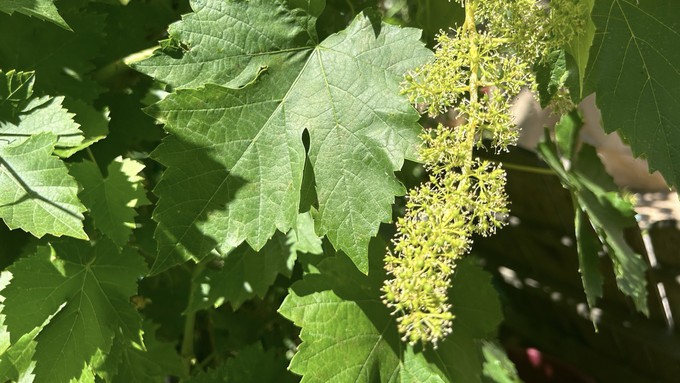
Spring growth gets heat check as Sacramento hits 90-plus

This incipient bunch of table grapes will be pruned by at least a third to focus the vine's energy in the grapes closest to the branch. Kathy Morrison
After roller-coaster weather patterns, Sacramento is experiencing something very normal – heat. And it’s just what our gardens need.
According to the National Weather Service, Sacramento will see its string of 90-degree days continue through Wednesday. By next weekend, afternoon highs will cool into the mid 80s. Overnight temperatures are warming, too, staying in the high 50s.
Normal for mid May in Sacramento: Highs of 80 degrees and lows of 51.
It’s about time this heat showed up. Sacramento recorded its first 90-degree day of 2024 on Friday (May 10) when downtown hit 92 degrees. In 2023, the first 90-degree day was April 27, says the weather service. On average, Sacramento sees the first 90-degree day on May 4.
Our soon-to-be summer gardens need this warmth. You’ll see the effects immediately.
Warm nights as well as hot days will increase soil temperatures. That’s a good thing; tomatoes, peppers, eggplant and other summer favorites need warm soil to grow, and respond rapidly.
More than 10 degrees above normal, this May heat will speed growth in many plants (especially weeds). They’ll quickly go to seed – don’t let them.
In their first flush of blooms, roses will fade more quickly on hot days; cut bouquets in the morning to enjoy indoors.
Lawns will grow faster, too. New shoots on shrubs and perennials will almost appear before your eyes. Fruit will develop quickly on trees (and may need thinning).
All this growth means your garden is thirsty. Recent rain gave plants some moisture reserves, but give your garden some extra irrigation this week – especially young seedlings or new transplants.
Another plus for 90-degree days: Heat kills fungal diseases. Days over 90 degrees will stop powdery mildew outbreaks; the fungus can’t replicate when temperatures are too high. That’s good news for roses and grapes.
Get your gardening chores and irrigation done early in the day before temperatures rise.
* Plant, plant, plant! It’s prime planting season in the Sacramento area. Time to set out those tomato transplants along with peppers and eggplants. Pinch off any flowers on new transplants to make them concentrate on establishing roots instead of setting premature fruit.
* Direct-seed melons, cucumbers, summer squash, corn, radishes, pumpkins and annual herbs such as basil.
* Harvest cabbage, lettuce, peas and green onions. This heat will cause leafy greens and onions to flower; pick them before they bolt.
* In the flower garden, direct-seed sunflowers, cosmos, salvia, zinnias, marigolds, celosia and asters.
* Plant dahlia tubers. Other perennials to set out include verbena, coreopsis, coneflower and astilbe.
* Transplant petunias, marigolds and perennial flowers such as astilbe, columbine, coneflowers, coreopsis, dahlias, rudbeckia and verbena.
* Keep an eye out for slugs, snails, earwigs and aphids that want to dine on tender new growth.
* Feed summer bloomers with a balanced fertilizer.
* For continued bloom, cut off spent flowers on roses as well as other flowering plants.
* Got fruit trees? If you haven't already done so, thin orchard fruit such as apples, peaches, pears, pluots and plums before they grow too heavy, breaking branches or even splitting the tree. Leave the largest fruit on the branch, culling the smaller ones, and allow for 5 to 6 inches (or a hand's worth) between each fruit.
* Thin grape bunches, again leaving about 6 inches between them. For the remaining bunches, prune off the "tail" end, about the bottom third of the bunch, so that the plant's energy is concentrated in the fruit closest to the branch.
* As spring-flowering shrubs finish blooming, give them a little pruning to shape them, removing old and dead wood. Lightly trim azaleas, fuchsias and marguerites for bushier plants.
* Add mulch to the garden to help keep that precious water from evaporating. Mulch also cuts down on weeds. But don’t let it mound around the stems or trunks of trees or shrubs. Leave about a 6-inch to 1-foot circle to avoid crown rot or other problems.
Comments
0 comments have been posted.Sacramento Digs Gardening to your inbox.
Sites We Like
Garden Checklist for week of July 21
Your garden needs you!
* Keep your vegetable garden watered, mulched and weeded. Water before 8 a.m. to reduce the chance of fungal infection and to conserve moisture.
* Feed vegetable plants bone meal, rock phosphate or other fertilizers high in phosphate to stimulate more blooms and fruiting. (But wait until daily high temperatures drop out of the 100s.)
* Don’t let tomatoes wilt or dry out completely. Give tomatoes a deep watering two to three times a week.
* Harvest vegetables promptly to encourage plants to produce more. Squash especially tends to grow rapidly in hot weather. Keep an eye on zucchini.
* Pinch back chrysanthemums for bushy plants and more flowers in September.
* Remove spent flowers from roses, daylilies and other bloomers as they finish flowering.
* Pinch off blooms from basil so the plant will grow more leaves.
* Cut back lavender after flowering to promote a second bloom.
* It's not too late to add a splash of color. Plant petunias, snapdragons, zinnias and marigolds.
* From seed, plant corn, pumpkins, radishes, winter squash and sunflowers.